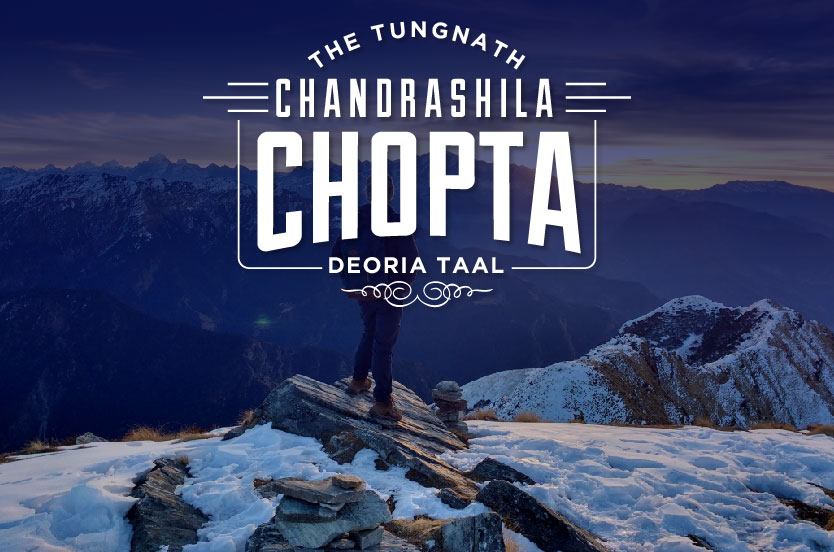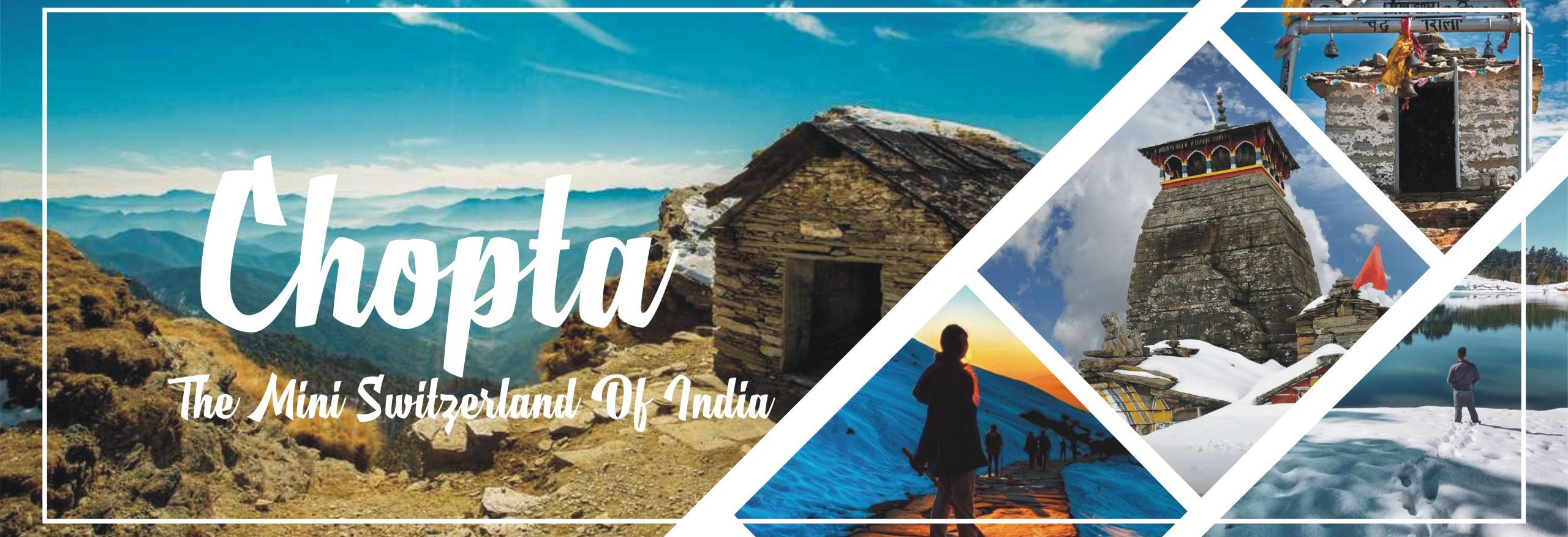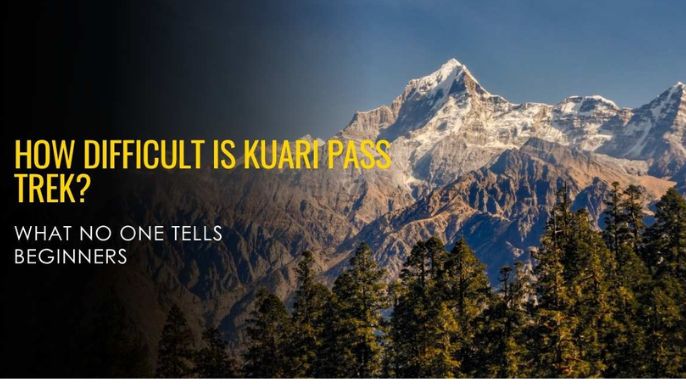Is there snowfall in Chopta?
Published on August 26, 2025
Yes, Chopta does receive snowfall, and it is one of the main reasons travelers love visiting this small Himalayan village in winter. Located in the Rudraprayag district of Uttarakhand, Chopta stands at an altitude of about 2,600 meters, making it a perfect spot to witness fresh layers of snow. The snowfall usually begins by late December and continues till February, covering the meadows, forests, and peaks with a soft white sheet. Walking through snow-covered pine and deodar trees feels magical, and the cold mountain breeze adds to the charm. Many trekkers plan their journeys during this time to enjoy the winter beauty of Tungnath and Chandrashila, which look even more stunning when covered in snow.
If you are planning a winter holiday, choosing a Chopta Tour Package from Delhi can make your trip smooth and comfortable. With travel, stay, and guided treks already arranged, you can enjoy Chopta’s snowy surroundings without any stress. From sipping hot tea near a campfire to waking up to white mornings and trekking through frozen trails, the experience is unforgettable. Snowfall in Chopta is not just a season—it is a memory that stays with you long after the trip.
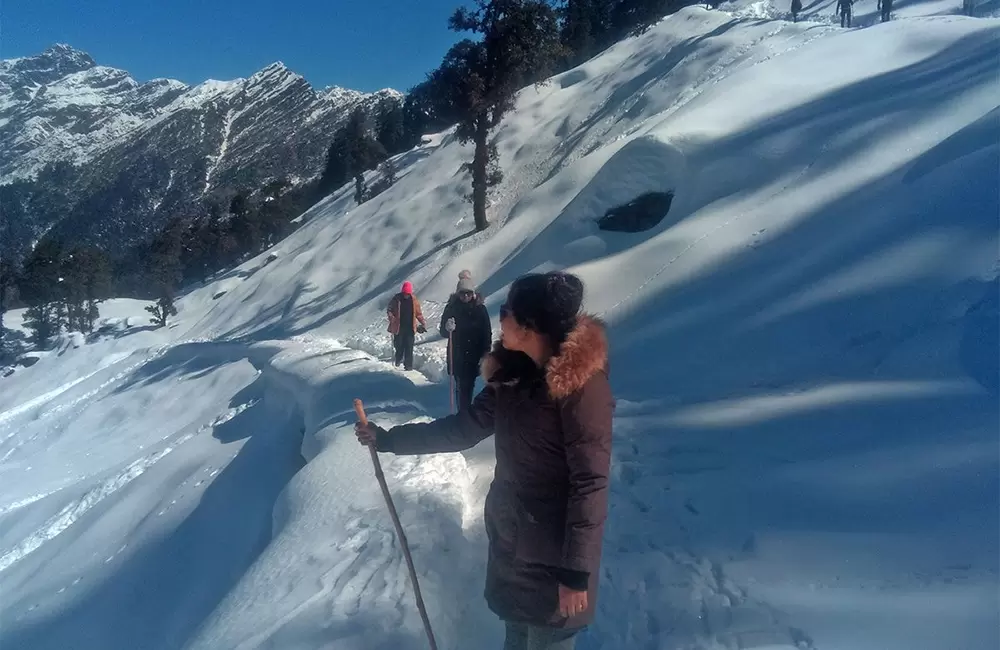
Itinerary for 3 Nights / 4 Days Chopta Tour with Deoria Tal
Day 0: Delhi to Rishikesh to Sari Village
- Departure: Start your journey from Botanical Garden Metro Station at 10:00 PM.
- Overnight Journey: Travel overnight towards Sari Village via Rishikesh.
- Stop at Devprayag: Witness the mesmerizing confluence of the Bhagirathi and Alaknanda rivers along the way.
Day 1: Sari Village to Deoriatal
- Arrival at Sari Village: Check into your homestay and take some time to freshen up.
- Trek to Deoriatal: Begin your trek to Deoriatal (2.5 km, approximately 1.5–2 hours).
- Enjoy Deoriatal: Soak in the serene beauty of the lake and the surrounding landscapes.
- Return to Sari Village: Head back to Sari Village and enjoy a peaceful evening.
Day 2: Sari Village to Tungnath & Chandrashila
- Breakfast: Start your day with a hearty breakfast at your homestay.
- Drive to Chopta: A scenic drive of about 1 hour from Sari Village.
- Trek to Tungnath Temple: Embark on a 3.5 km trek to the sacred Tungnath Temple.
- Summit Chandrashila: Extend your trek by 1.5 km to reach the breathtaking Chandrashila summit.
- Return to Chopta/Sari: After the trek, return to Chopta or Sari for an overnight stay at the campsite.
Day 3: Chopta to Delhi
- Breakfast: Enjoy an early breakfast at your campsite in Chopta.
- Departure: Begin your journey back to Delhi in the early morning.
- Visit Dhari Devi Temple: Stop by the revered Dhari Devi Temple en route.
- Arrival in Delhi: A long drive of approximately 10–12 hours marks the end of your adventure.
Inclusion
-
One Night Accommodation In Sari Village.
-
One Night Accommodation In Chopta/Sari Village.
-
4 Meals Will Be Provided Throughout The Trip.
-
AC Transportation.
-
Guide while trekking.
-
Experienced Trip Captain Throughout The Trip.
Exclusion
-
5% GST
-
Extra Drinks, Food, Tea, and Snacks.
-
Tickets for any sightseeing or extra activity outside the camp area.
-
Travel Insurance and other benefits.
-
Anything that is not mentioned in the inclusions.
-
Cost escalation due to any unforeseen reason, like weather, road conditions, landslide, etc.

Why Visit Chopta? – Reasons to Plan Your Himalayan Escape
Chopta is often called the “mini Switzerland of Uttarakhand” not just for its scenic charm but also for the unique experiences it offers. Unlike the usual crowded hill stations, Chopta still holds its untouched beauty with rolling meadows, dense forests, and majestic Himalayan peaks in the backdrop. It is one of those rare destinations where you can pause, breathe in the fresh mountain air, and let the calmness of nature refresh your soul.
Here are some strong reasons to plan a Chopta tour soon:
-
Adventure & Trekking: Chopta is the starting point of the famous Tungnath and Chandrashila trek, which combines spirituality, thrilling climbs, and breathtaking summit views.
-
Unspoiled Natural Beauty: With snow-clad winters, lush green summers, and colorful monsoons, Chopta offers a different charm in every season.
-
Peaceful Atmosphere: Unlike commercial hill stations, Chopta is quiet and less crowded, making it perfect for those who seek relaxation in nature.
-
Photography Paradise: From sunrise over the Chaukhamba peaks to starry night skies, Chopta gives photographers endless opportunities for stunning shots.
-
Birdwatching & Wildlife: Chopta’s forests are home to rare Himalayan birds and wildlife, attracting nature lovers and birdwatchers from all over the country.
-
Local Culture & Hospitality: Staying in homestays or mountain camps lets you experience the Garhwali lifestyle and warm village hospitality.
Opting for a Chopta tour package ensures that your travel, stay, meals, and treks are well-organized, so you can focus on enjoying the Himalayan beauty without stress. Whether it’s a short weekend break or a longer holiday, Chopta is the perfect escape where peace and adventure meet.
How to Reach Chopta? (By Air, Train & Road Options)
Reaching Chopta is part of the adventure. Since there are no direct flights, trains, or buses that drop you right into the meadows, travelers usually combine different routes depending on time and budget. Here’s a clear breakdown to make your journey easier.
-
Fastest Route (Flight + Road):
If you want to save time, fly into Dehradun’s Jolly Grant Airport. From there, Chopta is about 7–8 hours by road. You can book a private taxi or take a shared cab via Rishikesh → Rudraprayag → Ukhimath → Chopta. -
Comfortable Route (Train + Road):
The closest big station is Haridwar, connected with Delhi by overnight trains like Shatabdi and Mussoorie Express. Once you get down, take a cab or local bus towards Rudraprayag. From Rudraprayag, it’s a 70 km ride via Ukhimath that finally brings you to Chopta. -
Scenic Route (Direct Road from Delhi):
Many trekkers prefer this while planning the Chopta Tungnath trek from Delhi. The road journey is about 450 km and takes 10–12 hours. The route goes through Rishikesh, Devprayag, Srinagar, and Rudraprayag before the final climb towards Chopta. Driving yourself is possible, but mountain roads can be tricky, so many travelers hire cabs or join group departures.
For those aiming at the Chopta Chandrashila trek from Delhi, the road option is most popular as it allows flexibility—stop at Sari Village for Deoria Tal, spend a night in Ukhimath, or directly camp at Chopta.
No matter which route you pick, the journey to Chopta is filled with mountain rivers, pine forests, and glimpses of snow peaks—almost like a warm-up before the real adventure begins.
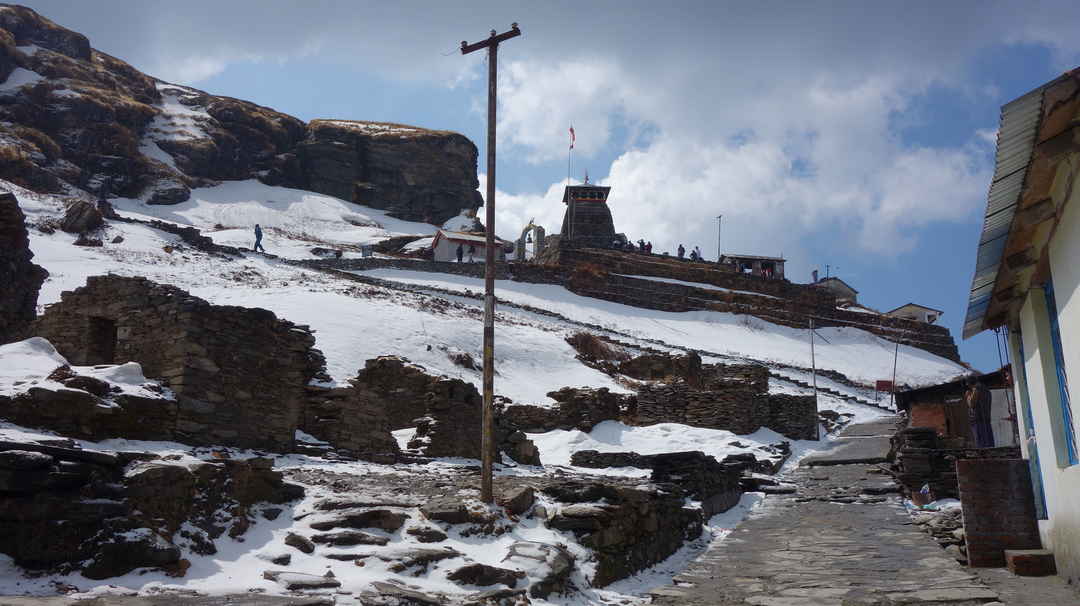
Best Time to Visit Chopta – Month-Wise Travel Guide
One of the most common questions travelers ask before planning their trip is, “What is the best time to visit Chopta?” The answer depends on the kind of experience you are looking for. Chopta changes its beauty with every season. Whether you want to enjoy green meadows, walk through misty monsoon trails, or experience snowfall, Chopta has something unique to offer all year round. Below is a month-wise guide that will help you choose the right season, especially if you are planning the Chopta Tungnath trek or the Chandrashila trek.
Chopta in Summer (March–June)
Summer is the most popular season to visit Chopta. The weather stays pleasant with temperatures ranging between 10°C and 25°C. The meadows are lush green, and wildflowers brighten up the trails. This is also the best time for the Chopta Tungnath trek, as the path to the temple is open and safe without snow. Trekkers who continue further to Chandrashila are rewarded with clear views of Himalayan peaks like Nanda Devi, Trishul, and Chaukhamba. Summer is also comfortable for camping, birdwatching, and easy family trips.
Chopta in Monsoon (July–September)
The monsoon paints Chopta in fresh shades of green. Forests and meadows come alive, but rain can make the trails slippery. While long treks may be a bit challenging, this season is loved by those who enjoy solitude, misty landscapes, and photography. Deoria Tal looks especially magical during these months with its mirror-like reflections of snow peaks. The Chandrashila trek becomes more adventurous in the monsoon, though good shoes and rain gear are a must. Fewer crowds also make this time peaceful for travelers seeking quiet.
Chopta in Winter & Snowfall (October–February)
For those who dream of snow, winter is the best time to visit Chopta. From December to February, the entire region turns into a snowy wonderland. Trekking to Tungnath becomes an exciting adventure in the snow, and climbing to Chandrashila is even more thrilling with frozen trails and wide views of the Himalayas. Temperatures can drop below zero, so warm clothing and proper gear are essential. Winter is perfect for those who want to combine trekking with the joy of snowfall and witness Chopta’s raw Himalayan charm.
In short, summer is best for clear treks and easy travel, monsoon for greenery and peace, and winter for snow adventures. Whether it’s the Chopta Tungnath trek or the Chandrashila trek, every season gives a different flavor of this Himalayan escape.

Famous Places to Visit Near Chopta
Chopta is not just about meadows and peaceful landscapes—it is also surrounded by some of the most famous spiritual and adventure destinations in Uttarakhand. From ancient temples to high-altitude treks and crystal-clear lakes, several attractions around Chopta make your trip more memorable. If you are planning the Tungnath temple trek or the Chandrashila summit trek, these nearby places will perfectly complete your journey.
1. Tungnath Temple – Highest Shiva Temple in the World
Located at an altitude of 3,680 meters, Tungnath is the highest Shiva temple in the world and a major highlight of the Tungnath temple trek. The 3.5 km trek from Chopta is moderately easy and passes through pine and rhododendron forests. Apart from spiritual importance, the temple offers incredible views of snow-covered Himalayan peaks, making it a must-visit for both pilgrims and trekkers.
If you want to read more about this place, [click here – Chopta Tungnath trek].
2. Chandrashila Peak – Sunrise & Summit Trek
Just 1.5 km above Tungnath lies Chandrashila Peak at 4,000 meters. The Chandrashila trek is short but slightly steep, rewarding trekkers with 360-degree views of mighty peaks like Nanda Devi, Chaukhamba, and Trishul. Many trekkers start early morning for the Chandrashila summit trek to witness one of the most breathtaking sunrises in the Himalayas.
If you want to read more about this place, [click here – Chandrashila trek].
3. Deoria Tal – Lake with Mountain Reflections
At about 2,400 meters, Deoria Tal is a stunning lake known for its crystal-clear water and mirror-like reflections of the Chaukhamba peaks. The 2.5 km hike from Sari Village makes it accessible for beginners and families. Camping near the lake under starlit skies is one of the best experiences around Chopta.
If you want to read more about this place, [click here – Deoria Tal trek].
4. Sari Village – Gateway to Deoria Tal
A charming little hamlet, Sari is the starting point for the trek to Deoria Tal. Staying in homestays here gives you a taste of Garhwali culture, warm hospitality, and local food. It’s also a good base for exploring nearby treks.
If you want to read more about this place, [click here – Sari Village].
5. Ukhimath – Winter Seat of Kedarnath
Known as the winter seat of Lord Kedarnath, Ukhimath is an important spiritual town located just 30 km from Chopta. During winters, when Kedarnath remains snowbound, the deity is worshipped here. The town also has several ancient temples worth visiting.
If you want to read more about this place, [click here – Ukhimath].
6. Kartik Swami Temple – Offbeat Spiritual Trek
Located about 38 km from Chopta, Kartik Swami Temple is dedicated to Lord Kartikeya, the son of Lord Shiva. The short trek leading to the temple offers panoramic Himalayan views and is a peaceful spiritual escape away from crowds.
Whether it’s the adventure of the Tungnath temple trek, the thrill of the Chandrashila trek, or the calmness of Deoria Tal, every place near Chopta adds a different flavor to your Himalayan journey.
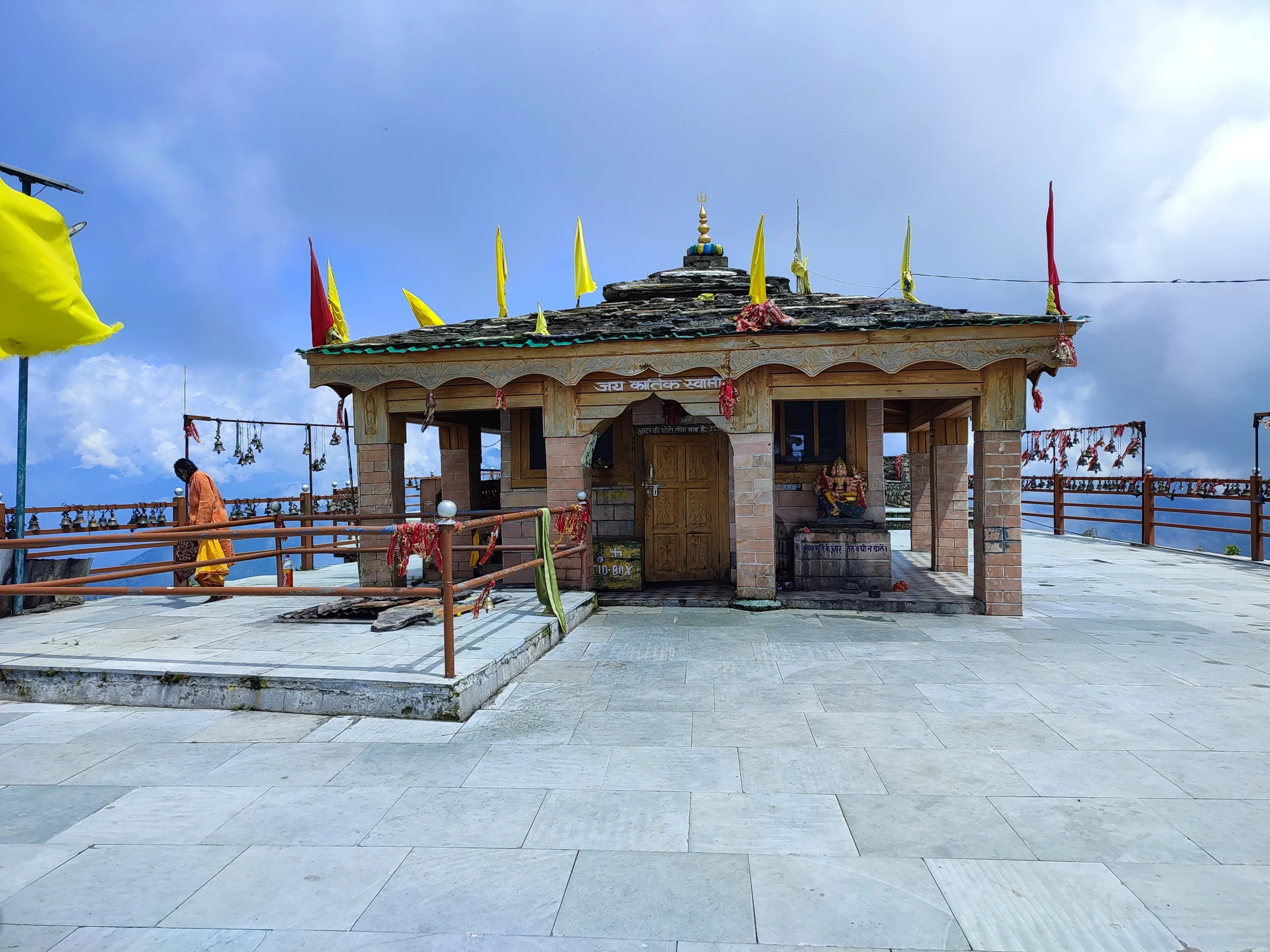
Trekking in Chopta – Tungnath & Chandrashila Adventure
The beauty of Chopta lies not only in its meadows and forests but also in the thrill of trekking to Tungnath and Chandrashila. For many travelers, this is the highlight of their trip. If you’re looking for a short yet rewarding Himalayan trek, the Chandrashila trek from Delhi or the Tungnath Chandrashila trek from Delhi is the perfect choice. In just a few days, you get to walk through pine forests, touch the clouds at Tungnath, and finally stand on the summit of Chandrashila with views that stretch across the Garhwal Himalayas.
Trek Difficulty & Duration
The Chopta treks are considered easy to moderate, which means they’re great for beginners but also satisfying for seasoned trekkers.
-
Chopta to Tungnath: 3.5 km trail, mostly stone-paved, takes 2–3 hours at a steady pace.
-
Tungnath to Chandrashila: 1.5 km uphill climb, steep but short, taking another 1–1.5 hours.
-
Round Trip: Expect 6–7 hours total with breaks, perfect for a day trek.
What makes this trek enjoyable is that you don’t need to dedicate weeks to it—you can feel the Himalayan adventure in just a weekend.
Trekking Tips for Beginners
To make the most of your trek, a few simple habits go a long way:
-
Start your trek before sunrise for magical views at Chandrashila.
-
Take small breaks instead of long halts to keep your energy steady.
-
Carry at least one water bottle and light snacks like dry fruits or energy bars.
-
If trekking in winter, rent microspikes or walk with a guide to navigate the snow safely.
-
Respect the environment—don’t litter and avoid loud music in the peaceful forests.
Essential Gear for Chopta Treks
Packing smart makes the trek more comfortable and enjoyable:
-
Shoes: Sturdy trekking shoes with good grip.
-
Clothing: Layered warm clothes for winter; light jackets for summer.
-
Extras: Cacp, sunglasses, and sunscreen for day treks.
-
Support: Walking stick for steep sections.
-
Safety: A Headlamp if you plan to start early morning.
A weekend on the Tungnath Chandrashila trek from Delhi is more than just a trek—it’s about feeling the silence of the mountains, watching golden sunrises, and returning home with a sense of peace and accomplishment.
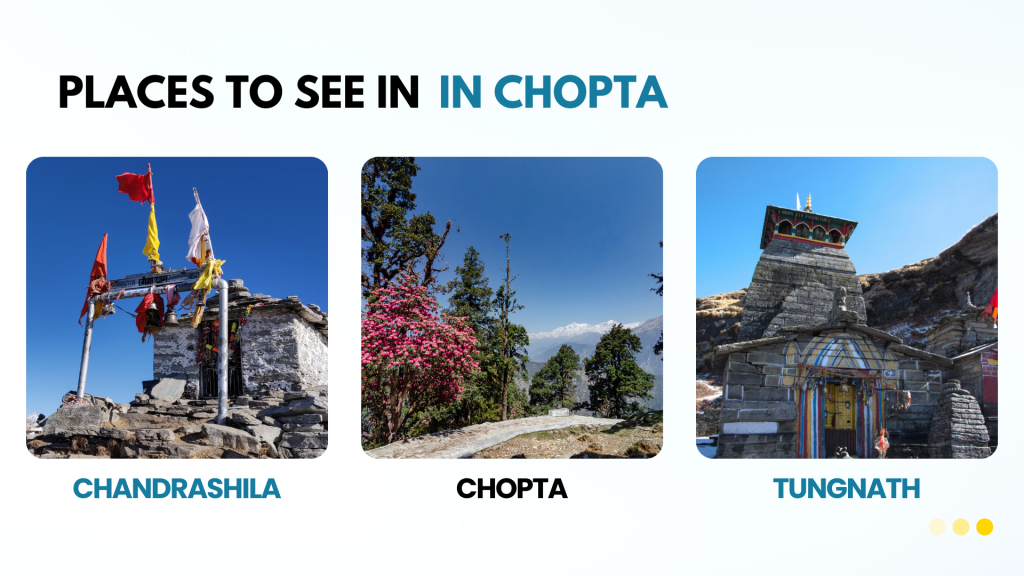
Where to Stay in Chopta? – Camps, Homestays & Guesthouses
One of the charming things about Chopta is that it doesn’t overwhelm you with big hotels or luxury resorts. Instead, the stay options here are simple, close to nature, and filled with warmth. Whether you’re a backpacker looking for budget comfort, a family seeking cozy rooms, or an adventure lover excited about camping under the stars, Chopta has something for everyone. Staying here is not just about accommodation—it’s about experiencing the mountain lifestyle.
Camps in Chopta
Camping is one of the most popular ways to stay in Chopta, especially for trekkers and adventure seekers. Waking up in a tent surrounded by forests, with the Himalayan peaks shining in the distance, is truly unforgettable.
-
Tents range from budget to luxury with attached washrooms.
-
Evening bonfires and stargazing make camping memorable.
-
Best for groups of friends and nature lovers who enjoy the outdoors.
Homestays in Chopta
Homestays are perfect for travelers who want to feel the warmth of local hospitality. Staying with families gives you a glimpse into Garhwali culture, traditions, and cuisine.
-
Rooms are basic but clean and comfortable.
-
Home-cooked meals with local flavors.
-
A chance to interact with villagers and hear mountain stories.
Guesthouses in Chopta
Guesthouses provide a middle ground between homestays and hotels. They are simple lodges or small properties located along the road towards Tungnath.
-
Budget-friendly with both private and shared rooms.
-
Hot water, electricity, and basic amenities are available.
-
Ideal for families and couples seeking convenience at affordable prices.
Staying in Chopta is less about luxury and more about the experience. Whether it’s a tent under the stars, a homestay with warm meals, or a guesthouse near the trekking trails, each stay option lets you feel the true spirit of the Himalayas.
Packing Checklist for Chopta Trip – Essentials for Every Season
A trip to Chopta is full of surprises—sunny meadows, sudden showers, chilly nights, and even snowfall if you visit in winter. To enjoy your journey without discomfort, packing smart is very important. Since the weather here changes quickly, carrying the right essentials ensures you stay warm, safe, and prepared. Here’s a season-wise checklist to help you get ready for your Chopta adventure:
Clothing Essentials
-
Summer (March–June):
-
Light woolens or jackets for evenings
-
Comfortable trekking pants and T-shirts
-
Sunglasses and caps for sun protection
-
-
Monsoon (July–September):
-
Quick-dry clothes
-
Raincoat or poncho
-
Waterproof trekking shoes
-
-
Winter (October–February):
-
Heavy woolens, thermals, down jackets
-
Woolen socks, gloves, and mufflers
-
Snow boots or sturdy trekking shoes
-
Trekking Gear
-
A sturdy backpack (40–50 liters)
-
Trekking poles for support
-
Headlamp or torch with extra batteries
-
Water bottles and a hydration bag
Personal Essentials
-
Sunscreen, lip balm, and moisturizer
-
Basic medicines and a first-aid kit
-
Power bank and extra charging cables
-
ID proof and permits if required
Other Must-Carry Items
-
Snacks like energy bars and dry fruits
-
A camera or a phone for capturing views
-
Small towel and toiletries
-
Extra plastic bags for wet clothes
Packing according to the season will keep you comfortable and safe while you explore Chopta, whether it’s for a peaceful walk in the meadows or an exciting trek to Tungnath and Chandrashila.

Travel Tips for Chopta – Network, ATMs, Medical Help & Insurance
Traveling to Chopta is a refreshing experience, but since it’s a remote Himalayan destination, being aware of practical details is just as important as enjoying the views. Good preparation can make your trip smooth, safe, and stress-free. Here are some useful tips every traveler should keep in mind before heading to Chopta:
Network Connectivity
-
Mobile networks are limited in Chopta.
-
Jio and BSNL work the best, while Airtel and Vodafone often lose coverage.
-
Internet speed is slow, so it’s better to inform your family about possible low connectivity.
ATMs & Cash Availability
-
Chopta doesn’t have ATMs.
-
The nearest ATMs are in Ukhimath (30 mins away) and Rudraprayag (2 hrs away).
-
Carry enough cash for a stay, food, and local expenses, as digital payments may not always work.
Medical Facilities
-
Basic medical aid is available at small shops and homestays.
-
For serious health issues, the nearest hospital is in Ukhimath.
-
If you have any specific condition, carry your personal medicines and a small first-aid kit.
Travel & Trekking Insurance
-
Trekking in Chopta, especially to Tungnath and Chandrashila, involves steep climbs and changing weather.
-
Taking travel or trekking insurance is recommended to cover emergencies like injuries or trip cancellations.
-
Many organized tour operators also provide insurance as part of their package.
Quick Tips
-
Inform your family about your itinerary before starting.
-
Keep emergency contacts handy.
-
Always trek with a guide if you’re a beginner.
Cultural Significance & Mythology of Chopta
Chopta is not only a paradise for nature and trekking lovers but also a land deeply rooted in mythology and spirituality. Every corner of this region whispers stories from ancient times, connecting travelers to India’s sacred past.
Tungnath Temple – A Sacred Legend
-
Tungnath, the highest Shiva temple in the world, is believed to be over 1000 years old.
-
According to legends, Lord Shiva appeared here after the Kurukshetra war when the Pandavas sought his blessings to atone for their sins.
-
It is said that the arms of Shiva emerged at Tungnath, making it one of the Panch Kedar shrines.
-
The temple stands at an altitude of 3,680 meters, and pilgrims still climb the trek to seek blessings amid breathtaking landscapes.
Chandrashila Peak – Seat of the Moon Rock
-
Chandrashila, meaning “Moon Rock,” is associated with several myths.
-
One belief is that Lord Rama meditated here after defeating Ravana.
-
Another legend says that Chandra, the Moon God, spent time in penance on this summit.
-
Today, trekkers not only enjoy the 360-degree Himalayan views but also connect with the spiritual aura of this sacred peak.
Ukhimath – Winter Seat of Kedarnath
-
When heavy snowfall makes Kedarnath inaccessible, the idol of Lord Shiva is shifted to Ukhimath.
-
Devotees worship here during the winter months, making Ukhimath a vital spiritual hub.
-
It is also considered the place where Usha, the daughter of Banasura, married Aniruddha, the grandson of Lord Krishna.
Why This Matters to Travelers
Exploring Chopta is more than just trekking; it’s walking through a landscape where mythology and nature coexist. Every temple and peak has a story, turning your journey into both an adventure and a spiritual experience.
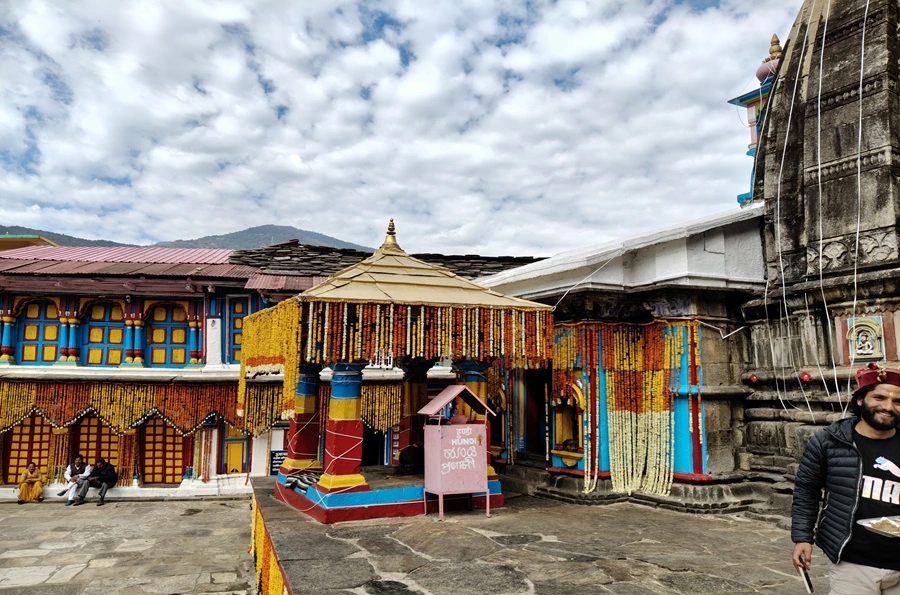
Responsible Travel Tips for Chopta – Eco-Friendly & Local Respect
Chopta’s beauty lies in its untouched meadows, clean air, and sacred trails. But this fragile Himalayan ecosystem can only stay pristine if travelers respect it. Being responsible here isn’t just about rules—it’s about giving back to nature and the communities that welcome you.
Eco-Friendly Travel Habits
-
Carry reusable bottles & cutlery – Avoid single-use plastic, as disposal in the mountains is limited.
-
Pack your waste – Always bring your trash back to proper bins in towns; don’t litter on trails.
-
Stick to marked paths – This protects the fragile alpine meadows and prevents soil erosion.
-
Save resources – Use electricity and water wisely, as supply is limited in remote villages.
Respect Local Culture & Community
-
Support homestays and local guides – This helps villagers earn directly from tourism.
-
Try Garhwali food – Eating local reduces transport impact and lets you experience authentic flavors.
-
Dress modestly around temples – Places like Tungnath and Ukhimath are sacred, so a little cultural sensitivity goes a long way.
-
Learn a few local phrases – Simple greetings in Garhwali or Hindi make interactions warmer and more personal.
Travel Mindfully
-
Keep noise low – Birds, animals, and fellow trekkers all value the mountain’s silence.
-
Respect wildlife – Don’t feed or disturb animals; observe them from a distance.
-
Leave no trace – The best souvenir you can take is a memory, not a footprint.
By traveling responsibly, you don’t just explore Chopta—you help preserve its charm for generations. Every small action counts in keeping these Himalayan meadows, trails, and temples as magical as they are today.
Photography Tips & Best Spots in Chopta – Capture the Himalayan Magic
Chopta isn’t just a trekking paradise—it’s a dream for photography lovers. From snow-kissed peaks to golden sunrises, every frame here feels like a postcard. To make the most of your trip, you need more than just a camera—you need timing, patience, and the right spots.
Best Spots for Photography in Chopta
-
Tungnath Temple – Ancient stone carvings with the Himalayas in the backdrop create stunning cultural shots.
-
Chandrashila Summit – Ideal for sunrise photography; the first rays lighting up Nanda Devi, Chaukhamba, and Trishul peaks are breathtaking.
-
Deoria Tal – A favorite among photographers for perfect reflections of snow peaks in the still waters.
-
Chopta Meadows – Wide-angle shots here capture rolling green (or snow-white) landscapes dotted with tall deodars.
-
Snow Trails in Winter – Perfect for candid portraits, drone shots, and creative storytelling.
Tips for Great Shots
-
Golden Hours – Shoot early morning or late evening for soft natural light.
-
Carry a Tripod – Essential for star trails, reflections, and sunrise shots at Chandrashila.
-
Wide & Zoom Lens Combo – Wide for landscapes, zoom for wildlife like the Himalayan monal and musk deer.
-
Drone Photography – Allowed in open areas, but avoid temples and restricted zones.
-
Pack Smart – Batteries drain fast in cold; keep them warm in your pockets.
Make It Personal
Don’t just click landscapes—capture your journey. Shots of sipping chai in a tent, walking snowy trails, or laughing with locals make your Chopta photo album unique.

Real Experiences of Chopta Travelers – Stories & Reviews
One of the best ways to understand the magic of Chopta is through the voices of travelers who have walked its trails, camped under the stars, and watched the golden sunrise from Chandrashila. Their experiences give a glimpse of what makes this destination so special.
Stories from Travelers
-
Rohan & Friends from Delhi
“We booked one of the affordable Chopta tour packages for a long weekend, and it was beyond our expectations. Trekking to Tungnath in the snow was both challenging and rewarding. The sunrise at Chandrashila summit felt like nature’s grand show—totally worth every step.” -
Meera, Solo Traveler
“Chopta gave me the peace I was searching for. The homestay experience was warm, and I bonded with local families who shared stories of Tungnath Temple’s legends. Watching snowfall for the first time in Chopta was pure magic.” -
Sharma Family
“Traveling with kids, we were unsure about trekking. But the gentle meadows, the sight of Himalayan peaks, and safe accommodation options made our trip memorable. The children loved playing in the snow and spotting birds near Deoria Tal.”
What Travelers Loved Most
-
The simplicity and warmth of the local people.
-
Freshly cooked Garhwali food after a long trek.
-
The variety of Chopta tour packages caters to solo travelers, families, and adventure seekers.
-
Unique experiences like camping under starlit skies and waking up to snow-covered peaks.
Reviews Summed Up
Most visitors agree that Chopta is not just a trekker’s delight but also a peaceful getaway for anyone who wants a break from city life. Whether it’s the spiritual pull of Tungnath, the thrill of Chandrashila, or the calm of Deoria Tal, every traveler returns with stories worth telling.

FAQs About Snowfall in Chopta
1. Does Chopta get snowfall every year?
Yes, Chopta receives snowfall every winter, usually from late December to February.
2. When is the best time to see snowfall in Chopta?
January is considered the peak month for experiencing fresh and thick snowfall in Chopta.
3. How much snowfall does Chopta get?
On average, Chopta receives heavy snowfall—enough to cover meadows, trails, and roads in a white blanket.
4. Can I do the Tungnath and Chandrashila trek during snowfall?
Yes, but it becomes challenging. You’ll need good shoes, warm gear, and sometimes a local guide for safety.
5. Is Chopta accessible during heavy snowfall?
Roads may get blocked for a few days after fresh snowfall, but usually, they are cleared quickly for travelers.
6. What clothes should I carry for Chopta in snowfall?
Thermals, heavy jackets, woolen caps, gloves, and waterproof trekking shoes are must-haves.
7. Are camps and hotels open in Chopta during snowfall?
Yes, though options may be fewer. Many camps and homestays remain functional with basic winter facilities.
8. Can families and kids enjoy snowfall in Chopta?
Absolutely! Families with kids often visit for snow play, but trekking in deep snow may not suit very young children.
9. Is it safe to drive to Chopta in winter?
Yes, but only if you are experienced with hilly roads. Hiring a local driver is recommended during heavy snow.
10. What makes snowfall in Chopta special?
It’s the combination of white meadows, Himalayan views, and peaceful vibes that makes the winter experience magical.
